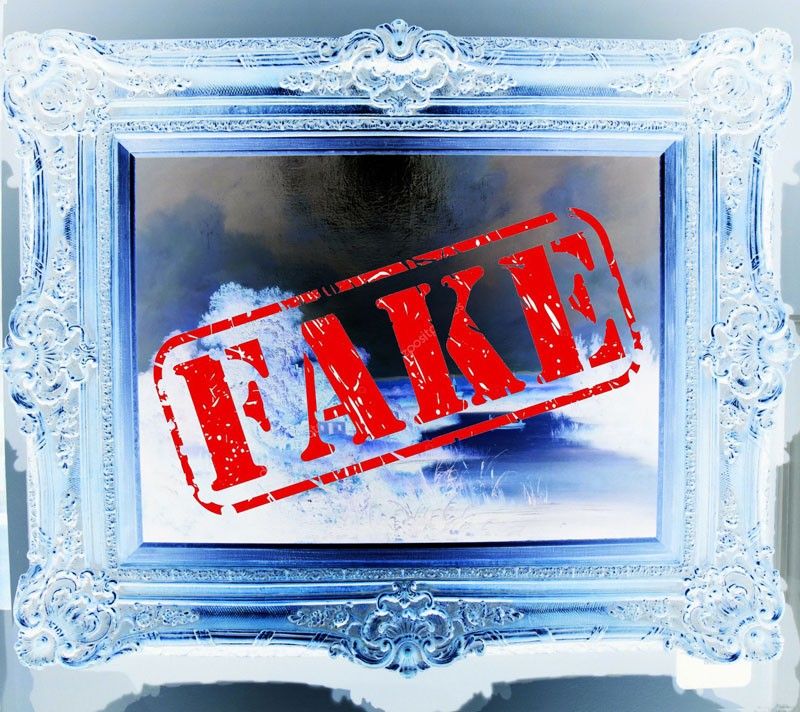The fake, the good, and the beautiful

As I’ve mentioned before, I’ve taken to collecting a bit of Philippine midcentury art over the past few years. You won’t see any Amorsolos, Kiukoks, Botongs, or Ocampos on our walls, because I simply don’t have the kind of loose change you need to bring home even one of those dazzlers. But I take pride in having put together a small but decent gathering of works mainly by Amorsolo’s students and juniors — typically pastorals by such gifted painters as Gabriel Custodio and Elias Laxa, depictions of a lost landscape that relax me and remind me of a time when — to use a phrase brazenly stolen by its opposite — the true, the good, and the beautiful prevailed.
Someone I know had the unfortunate and rather embarrassing experience of trying to help a friend dispose of some masters’ paintings — excellent examples of their kind that the friend had bought years earlier in good faith — through an auction house. The auctioneer was initially delighted to receive the works, but upon closer inspection raised small but troubling questions about the pieces (as they were of course obliged to do, with many millions and their reputation in the balance). Eventually the works had to be pulled out because they simply couldn’t be authenticated, which is one short and polite step away from saying that they’re, well, probably fake. They could look good and even be beautiful, but at the end of the day, they’re still fake.
This reminded me of the controversy that followed a big university’s mounting of a retrospective show of one of its most distinguished alumni, only to be told that a few of its prized exhibits were somebody else’s handiwork.
Ironically, I have to sheepishly confess to being taken in by a seller purporting to sell an old painting by this very same master at a bargain price — which, being new to buying art, I jumped at, after examining all the visual and physical evidence before me. The style was correct, as was the subject, including the little tell-tale touches that artists tend to populate their signature works with. The corners of the painting were thick with dust and the natural accretions of age. I knew there was a 50-50 chance I was being taken for a ride — the seller was offering no guarantees, no certificates of authenticity, so I wasn’t going to get my money back — and I hemmed and hawed for a bit, but it was finally the dust that suckered me into a deal; if I didn’t take it that minute, someone else would, so I might as well gamble. I was elated for a few hours, and then I began to do more visual research online, until I began to realize, with a crushing certainty, that I’d just bought a fake, because of one small but vital detail that the painter had gotten wrong (which I’m not about to divulge here, and which I’ve since spotted in other offerings of the same artist).
Even more ironically, of course, I’m married to one of the best art restorers and conservators in the country — but she can’t, doesn’t, and won’t authenticate artworks, knowing both the scholarship and the science required to do the job properly and credibly. The problem isn’t only that Certificates of Authenticity (COAs) can sometimes be too easily secured or bought from less than stellar sources, but also that COAs themselves have been faked. (If you can do a reasonably good copy of a masterwork, it shouldn’t be too hard to fake a piece of paper and a signature, right?)
With all the big money sloshing around in the art market these days, it’s easy to see how and why art forgery is also a booming sub-industry, going by what I’ve seen and heard out there. A persistent story that’s made the rounds is that of a warehouse-sized factory which an artist who’s made a name for himself, in his own right, has been assisted by apprentices in churning out fakes.
To be fair, it’s been going on since at least Michelangelo, whom scholars point out indulged in a bit of forgery himself, copying older works and passing them off as originals — an act generous critics would call a “triumph over antiquity.” You can read the full, fascinating story of history’s most notorious (or, to put it another way, most talented) art forgers here: https://bit.ly/2eWwQhI.
I wish we had a repository of artists’ signatures, organized by date or period. I’ve had good luck doing research online, where auction houses keep visual records of well-known artists’ works and sales figures. But proper authentication has to go beyond signatures and gut feel.
One friend closely related to a National Artist wants to set up a scientific laboratory for professionally authenticating art works, so that we don’t go simply by sight or the word of the artist’s relatives and friends. This could involve, among others, undertaking a chemical analysis of the materials used, comparing them to data stored in a bank that will also have to be, of course, set up and maintained. You’d think that this idea should fly easily among gallery owners and art patrons, but you’d also have to wonder how willing some people will be to subject their collections to microscopic scrutiny.
As we should’ve learned from the days of Michelangelo to this age of Twitter, the truth may not be beautiful, and what looks good may not be true.



















